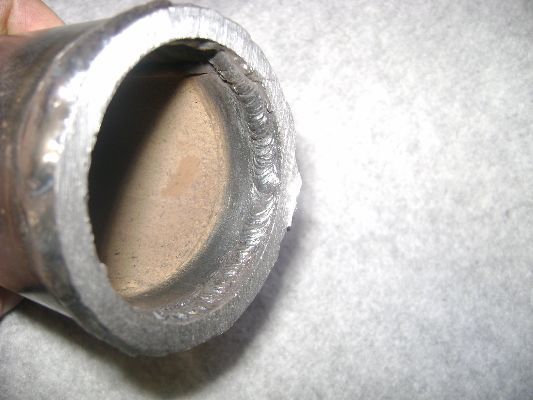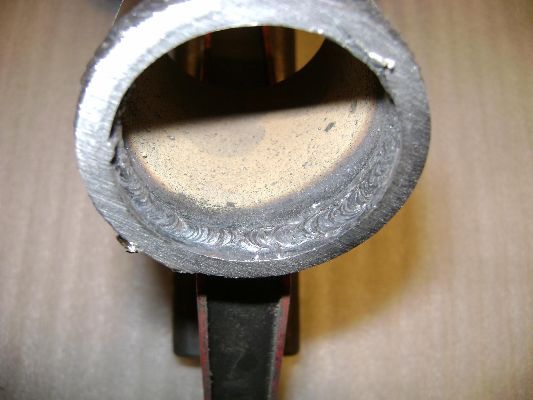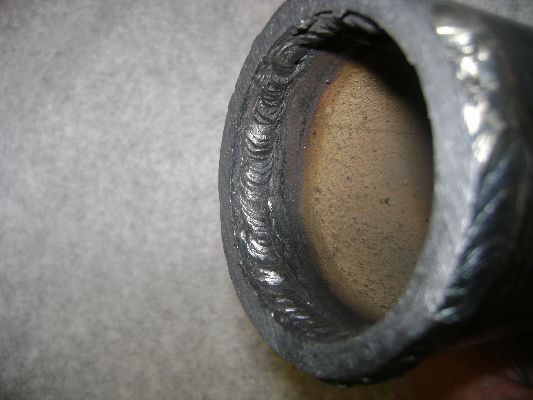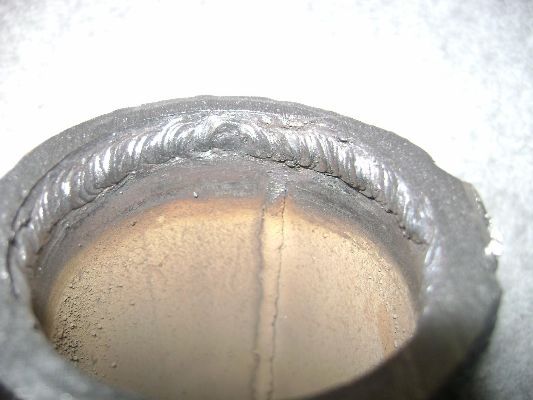First, I'm new to this site and to welding, so hello to everyone. Second, I need help with my welding and have questions.
OK, so I've been stick welding schedule 40 3"-10" pipe (with wall thicknesses between 0.216"-0.365"), and before welding the coupons I set my amps using a 0.375" steel plate (that's what's available). After finding the desired amps, the coupons, which have a 1/8" land and gap, are placed in the 2G position to be tacked (using 1/8" 6010). When they are tacked I always find that the amps are too high and so they are adjusted accordingly (I find running at about 68 amps works for me, as I like the keyhole to be more stable).
After the tacks are complete, the coupons are placed in the 5G position and the root pass is started at 6 o'clock (overhead). However, at this point I find the amps are to low, as the electrode just sticks, and the amps have to be adjusted again (up by about 5 amps). After this the root goes smoothly. Obviously the amps get a little hot while approaching the 12 o'clock position, but adjusting my hand technique in this situation seems to help in avoiding a blowout.
So, what I'd like to know is 1) is there a better method to set the amps before welding the pipe to avoid a blowout? and, 2) is it common practice in welding to have to adjust the amps simply because of the position of the weld?
As for the machine, I cant remember much about it, but it's a Miller with a 60% duty cycle, no arc force setting, I think its a rectifier and DC.
Thanks in advance everyone.
Stick Welding Tips, Certification tests, machines, projects
- Shield Arc
-
Guide

-
Posts:
-
Joined:Tue May 28, 2013 11:10 am
-
Location:Figuring the picking points of jelly donuts
Learning curve
- Learning curve
-
New Member

-
Posts:
-
Joined:Fri Oct 31, 2014 6:04 pm
The way the tacks go in should tell you the correct amps. Try just practice tacking all the way around a coupon, to get a better feel for the amps setting. I prefer a 1/8" land with a 3/32 gap for uphill 6010. 80 amps is where I have been running at using a lincoln invertec 350. The 10 to 12 o'clock position is going to be the hardest because gravity is working against you, the correct rod angle and travel speed is important on top.
^ Same machine. We were using 1/8 gap and land, and were told to run like 55-70 amps, which I thought was supposed to be way to cold, but that's how we did it. I tended to run on the higher side of things.
I went even hotter if I was trying the "bury rod" method.
Sent from my SM-T537R4 using Tapatalk
I went even hotter if I was trying the "bury rod" method.
Sent from my SM-T537R4 using Tapatalk
It's been a few days, but thanks for the tips guys. In regards to my original post, much more time under the hood is needed. That being said, from what I can tell about 12-15 more amps are needed (at least with the welder I'm using) in overhead when the pipe is in 5G. Also, I wasn't using the correct arc angle or pushing the electrode up tight enough in overhead like I thought I was. That electrode really needs to be up there!
As for welding pipe in 2G, I'm able to do it effectively with fewer or more amps. Doesn't matter as much. But things seem to be different in 5G and I gotta turn things up.
I've maintained the 1/8" root and land but in the morning will change to 3/32" for a try.
About the pics:
1.) this is how I grind my root pass, by holding the grinder at an angle to maintain somewhat of a bevel as I have found it helps prevent slag inclusion during the hot pass. Know of a better way?
2.) this is just a tack that was ground out.
3.) this tack was welded in 2G. The amps were set at what I would have to weld the pipe at in 5G to feel the difference. Though the key hole is big, it was manageable but I would still prefer lower amps for this position.
4.) this is the root pass between 6-4 o'clock and is particularly the most difficult portion of overhead for me. It's difficult to tell from the pic, but there is undercut and it's not uniform.
5.) the circled part is the tie in with the tack where it didn't fuse properly.
6.) after four weeks of welding various sizes in 5G and making little headway, I got very frustrated today after welding the first root pass on a coupon. I didn't like the results and let my anger get the best of me and threw my hood on the ground--twice! So there goes $130.00 down the drain. As for the hood itself, it's a Miller digital pro hobby and for the price and quality I'd recommend it to anyone just learning to weld as it has a decent size window and is lite. The only two down sides are that you can't torch cut (or grind) wearing it and isn't too great TIG welding. But, when I got home today I did order a used one.
Well, guys thanks again for the tips and let me know what you think.
As for welding pipe in 2G, I'm able to do it effectively with fewer or more amps. Doesn't matter as much. But things seem to be different in 5G and I gotta turn things up.
I've maintained the 1/8" root and land but in the morning will change to 3/32" for a try.
About the pics:
1.) this is how I grind my root pass, by holding the grinder at an angle to maintain somewhat of a bevel as I have found it helps prevent slag inclusion during the hot pass. Know of a better way?
2.) this is just a tack that was ground out.
3.) this tack was welded in 2G. The amps were set at what I would have to weld the pipe at in 5G to feel the difference. Though the key hole is big, it was manageable but I would still prefer lower amps for this position.
4.) this is the root pass between 6-4 o'clock and is particularly the most difficult portion of overhead for me. It's difficult to tell from the pic, but there is undercut and it's not uniform.
5.) the circled part is the tie in with the tack where it didn't fuse properly.
6.) after four weeks of welding various sizes in 5G and making little headway, I got very frustrated today after welding the first root pass on a coupon. I didn't like the results and let my anger get the best of me and threw my hood on the ground--twice! So there goes $130.00 down the drain. As for the hood itself, it's a Miller digital pro hobby and for the price and quality I'd recommend it to anyone just learning to weld as it has a decent size window and is lite. The only two down sides are that you can't torch cut (or grind) wearing it and isn't too great TIG welding. But, when I got home today I did order a used one.
Well, guys thanks again for the tips and let me know what you think.
- Attachments
-
- w 1.jpg (55.72 KiB) Viewed 11256 times
-
- w 7.jpg (64.79 KiB) Viewed 11256 times
-
- w 6.jpg (51.82 KiB) Viewed 11256 times
-
- w 4.jpg (46.08 KiB) Viewed 11256 times
-
- w-3.jpg (43.53 KiB) Viewed 11256 times
-
- w 8.jpg (61.41 KiB) Viewed 11256 times
- Shield Arc
-
Guide

-
Posts:
-
Joined:Tue May 28, 2013 11:10 am
-
Location:Figuring the picking points of jelly donuts
One thing that may help with tie ins to your tacks. When getting close to the tack, angle the rod towards the tack.
If I'm running too hot, or a big gap, I point the rod back on already deposited weld. If I'm running to cold, or the gap is closing up on me, I point the rod forward to have more of a cut.
If I'm running too hot, or a big gap, I point the rod back on already deposited weld. If I'm running to cold, or the gap is closing up on me, I point the rod forward to have more of a cut.
- Shield Arc
-
Guide

-
Posts:
-
Joined:Tue May 28, 2013 11:10 am
-
Location:Figuring the picking points of jelly donuts
Thank you!guille15 wrote:Also, Shield Arc, for someone who does strictly structural your root pass looks good.
- JerryWilliams
-
New Member

-
Posts:
-
Joined:Mon Oct 20, 2014 2:23 pm
-
Location:Cedartown, Ga
just a tip to help transition from overhead to vertical to flat on 5G. place your 4 tacks on the pipe as usual but when you tack the coupons in place to weld rotate the pipe to where the tacks are in the 1:30, 4:30, 7:30. and 10:30 positions. This way you weld overhead from 6 o'oclock to first tack. vertical from 4:30 to 1:30 and flat from 1:30 to 12. Same on reverse side of pipe. Your heat for 2G is a rough estimate for 5G. I like a 1/8th landing with 3/32 gap so i can bump the heat up a lil bit and bury the rod and speed along. But you gotta pay close attention to rod angle. It will effect your weld more than you think. If im already burning away and i feel like its cold i will angle back a lil more towards the weld to give it more heat. Just some tips. Good luck
Thanks for the tip, Jerry. I like the idea of changing the positions of my tacks. And you are right about the angle, it's more important than what I thought and by using it correctly I haven't had to make any amp adjustments in the past two days going from 2G-5G. So I am making some progress.
- Otto Nobedder
-
Weldmonger

-
Posts:
-
Joined:Thu Jan 06, 2011 11:40 pm
-
Location:Near New Orleans
There are many people here who are better than they let on...Shield Arc wrote:Thank you!guille15 wrote:Also, Shield Arc, for someone who does strictly structural your root pass looks good.
Why? Because we want to call ourselves craftsmen, and we are very hard on ourselves... Harsh critics.
Steve S
Tassie Dave
- Tassie Dave
-
Active Member

-
Posts:
-
Joined:Wed Sep 03, 2014 2:04 am
-
Location:Tasmania
I suppose Steve in my case anyway "i don't want to see my job fail " i have enough critics already and they would pounce on something like that quicker than you could jump."
I made wheelchair ramp for a mate and he gave me two lengths of 75 mm angle which i had to cut and then weld shut to form a U channel.The track was 1.9 m long when finished and had a join in the middle. I had to put a hinge in so he could fold the unit up and put it in the back of his Landcruiser. I put extra safety features into the ramp in case the hinge failed ( it did ) and would not collapse. Thank goodness i did that, no casualties. He had the steel hinges replaced with stainless steel.
And of course i found out all of this through the hecklers not the owner. When i caught up with him he said that the hinge gave out not the welding. Hecklers

I made wheelchair ramp for a mate and he gave me two lengths of 75 mm angle which i had to cut and then weld shut to form a U channel.The track was 1.9 m long when finished and had a join in the middle. I had to put a hinge in so he could fold the unit up and put it in the back of his Landcruiser. I put extra safety features into the ramp in case the hinge failed ( it did ) and would not collapse. Thank goodness i did that, no casualties. He had the steel hinges replaced with stainless steel.
And of course i found out all of this through the hecklers not the owner. When i caught up with him he said that the hinge gave out not the welding. Hecklers
I have an
Esab LHQ 150
Pro Weld TC256 ACDC multi process Tig Cut MMA
WeldSmart Mig 200IGBT Mig Tig MMA and spool gun
Esab LHQ 150
Pro Weld TC256 ACDC multi process Tig Cut MMA
WeldSmart Mig 200IGBT Mig Tig MMA and spool gun
- Otto Nobedder
-
Weldmonger

-
Posts:
-
Joined:Thu Jan 06, 2011 11:40 pm
-
Location:Near New Orleans
Tassie Dave,
That's brilliant! That's what separates the craftsmen. You saw a weak point in the design, and built a protection around it, and it worked!
The hecklers may still rib you, but you did it right, and in the end they can kiss you where the sun doesn't shine!
I'm at a point in my career where I will NOT be pushed. Faster does not equal better. I'll do it right, or you can get someone else.
Steve S
That's brilliant! That's what separates the craftsmen. You saw a weak point in the design, and built a protection around it, and it worked!
The hecklers may still rib you, but you did it right, and in the end they can kiss you where the sun doesn't shine!
I'm at a point in my career where I will NOT be pushed. Faster does not equal better. I'll do it right, or you can get someone else.
Steve S
Tassie Dave
- Tassie Dave
-
Active Member

-
Posts:
-
Joined:Wed Sep 03, 2014 2:04 am
-
Location:Tasmania
Steve
Thanks for the advice mate, i value your input mate.
A friend of mine who is an Engineer oversaw the job and he suggested the failsafe along with my input. He reckoned my welds would all have passed x ray.
I take pride in what i do and like you mate, i will not be rushed by no bastard. I have told them that and most respect my views.
Thanks for the advice mate, i value your input mate.
A friend of mine who is an Engineer oversaw the job and he suggested the failsafe along with my input. He reckoned my welds would all have passed x ray.
I take pride in what i do and like you mate, i will not be rushed by no bastard. I have told them that and most respect my views.
I have an
Esab LHQ 150
Pro Weld TC256 ACDC multi process Tig Cut MMA
WeldSmart Mig 200IGBT Mig Tig MMA and spool gun
Esab LHQ 150
Pro Weld TC256 ACDC multi process Tig Cut MMA
WeldSmart Mig 200IGBT Mig Tig MMA and spool gun
christhewelder75
- christhewelder75
-
Active Member

-
Posts:
-
Joined:Sun Aug 10, 2014 11:15 am
personally I like a 1/8th land with a tight 3/32 gap run at about 100amps i pretty much keep pressure into the gap pushing the rod as i feel the land melt and give free then step and push. My last welding instructor was surprised i ran that hot, but the results dont lie. all my coupons bent fine. I also kept detailed notes in my "welding bible" on all the variables for given welds/positions so that i wouldnt have to guess and test too much. i could go into my booth set my machine and get repeatable results every time given i did my prep work properly.
i dont have my notes on me but im pretty sure i used the same settings for all my roots with 6010 and it was the fill and cap with 7018 where i had to adjust settings based on position.
but as i said thats just me. for every welder theres a different technique we like to use
i dont have my notes on me but im pretty sure i used the same settings for all my roots with 6010 and it was the fill and cap with 7018 where i had to adjust settings based on position.
but as i said thats just me. for every welder theres a different technique we like to use
Return to “Stick Welding/Arc Welding - Shielded Metal Arc Welding”
Jump to
- Introductions & How to Use the Forum
- ↳ Welcome!
- ↳ Member Introductions
- ↳ How to Use the Forum
- ↳ Moderator Applications
- Welding Discussion
- ↳ Metal Cutting
- ↳ Tig Welding - Tig Welding Aluminum - Tig Welding Techniques - Aluminum Tig Welding
- ↳ Mig and Flux Core - gas metal arc welding & flux cored arc welding
- ↳ Stick Welding/Arc Welding - Shielded Metal Arc Welding
- ↳ Welding Forum General Shop Talk
- ↳ Welding Certification - Stick/Arc Welding, Tig Welding, Mig Welding Certification tests - Welding Tests of all kinds
- ↳ Welding Projects - Welding project Ideas - Welding project plans
- ↳ Product Reviews
- ↳ Fuel Gas Heating
- Welding Tips & Tricks
- ↳ Video Discussion
- ↳ Wish List
- Announcements & Feedback
- ↳ Forum News
- ↳ Suggestions, Feedback and Support
- Welding Marketplace
- ↳ Welding Jobs - Industrial Welding Jobs - Pipe Welding Jobs - Tig Welding Jobs
- ↳ Classifieds - Buy, Sell, Trade Used Welding Equipment
- Welding Resources
- ↳ Tradeshows, Seminars and Events
- ↳ The Welding Library
- ↳ Education Opportunities





